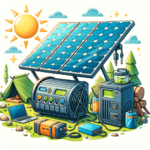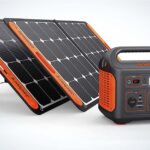When the lights go out and chaos knocks on your door, will your home be ready? Power outages are no longer rare events—they’re becoming more frequent and severe due to extreme weather, overloaded grids, and unexpected failures. A whole-house emergency power plan isn’t just a smart idea—it could be the difference between comfort and crisis when disaster strikes.
Why Every Home Needs an Emergency Power Plan
A whole-house emergency power plan is a prepped system designed to provide electricity to critical areas of your home when the main grid fails. It includes backup power sources, fuel management, transfer equipment, and safety strategies. The goal is simple: keep your family safe, your home functioning, and your stress levels low.
Common scenarios where emergency power becomes critical include hurricanes, blizzards, wildfires, heatwaves, and even planned rolling blackouts. In each of these, losing power can disable vital appliances—fridges, medical devices, sump pumps—and leave your home vulnerable. Planning ahead ensures you aren’t left scrambling in the dark.
The process begins with evaluating your true power needs, then choosing the right power system. You’ll need to include installation elements, backup fuel planning, safety checks, budgeting, and regular maintenance in your plan. Let’s dive into each step.
Evaluating Your Home’s Power Needs
Start by identifying which systems and appliances are essential. These might include your refrigerator, heating or cooling systems, medical devices, lighting, internet routers, and sump pumps. For some families, well pumps or security systems might also be critical.
Next, calculate the wattage each device uses. You can typically find wattage information on the nameplate of each appliance or in its manual. Add up these watts to determine total power needs during an outage.
Once you have a total, prioritize what should run simultaneously. For example, rather than trying to power the entire home, focus on high-priority systems. You may decide to alternate between appliances to extend your power supply.
Choosing the Right Backup Power Solution
There are several types of emergency power systems, and your choice will depend on your power needs, geography, and budget. The most common options include:
- Portable generators – affordable and flexible, but require manual setup and fueling.
- Standby generators – permanently installed systems that turn on automatically during outages.
- Battery backups – quiet and clean, ideal for smaller loads or short outages.
- Solar with battery storage – sustainable but higher upfront cost, especially when paired with enough capacity to power major appliances.
Fuel type also matters. Gasoline is easy to find but degrades quickly and emits more fumes. Propane stores well and is clean-burning, while diesel is highly efficient but harder to store long-term. Natural gas requires a fixed utility supply but offers lower operational costs for standby systems.
Both portable and standby generators have pros and cons. Portables are cheaper but louder and require manual effort. Standby models are more seamless and powerful—but carry a higher installation cost.
Safely Connecting Power to Your Home
You can’t just plug a generator into your home’s wall outlet. Doing so can backfeed electricity into the grid—endangering utility workers and potentially damaging appliances. That’s why you need the proper transfer setup.
Install either a manual or automatic transfer switch to safely manage the power changeover. These devices isolate your home’s wiring from the grid, directing generator or backup power solely to designated circuits.
Consider installing a dedicated subpanel for your emergency circuits. This allows you to organize essential systems in one location and avoids overloading the generator. Always consult a licensed electrician for code-compliant installation—especially since mistakes can lead to fire hazards.
Managing Fuel Supply and Storage
Understanding your fuel consumption is crucial. A standard portable generator might burn 1-2 gallons of gas per hour, depending on the load. A 5000-watt generator running 8 hours per day could consume up to 16 gallons in two days.
Store fuel in UL-approved containers, away from living areas and ignition sources. Gasoline should be treated with stabilizers and rotated every few months. Propane tanks should be inspected regularly and kept upright in well-ventilated locations.
To prevent contamination, keep fuel containers sealed tightly, labeled, and stored off the ground. Avoid metal cans that can rust and compromise fuel integrity.
Keeping the System Maintained and Reliable
Backup power systems won’t help if they fail when you need them most. That’s why maintenance is non-negotiable. Regular oil changes, spark plug replacements, and fuel filter checks will keep your generator in peak condition.
Battery systems also require upkeep. Check for corrosion, voltage levels, and charge retention. Replace aging batteries well before they reach end-of-life.
Test your system under real load conditions every 1–2 months. This ensures that when the grid goes down, your emergency system powers up without a hitch.
Developing a Practical Usage Plan
With power in short supply during an outage, efficiency is key. Schedule appliance use to avoid overload—for example, run the refrigerator and microwave in separate time blocks. Use LED lighting to conserve energy.
Establish emergency priorities. This might mean keeping the fridge running and phones charged over less essential comfort items.
Most crucially, make sure everyone in the house knows the power plan. Label appliances that can be used, create a simple checklist, and practice your outage routine regularly.
Essential Safety Guidelines
“If not used properly, backup generators can pose serious hazards,” warns the National Fire Protection Association (NFPA). Carbon monoxide poisoning is a leading concern. Always operate generators outdoors, at least 20 feet from the home, with exhaust pointing away from doors and windows.
Ensure proper airflow around generators or battery systems. Never use gas-powered equipment inside garages—even with the door open.
Secure your equipment from both weather and theft. Use enclosures, lock cables, and invest in weatherproof covers where needed.
Assembling an Emergency Power Kit
Build an emergency power tool kit—complete with heavy-duty extension cords, spare fuses, voltage testers, and instruction manuals. Keep fuel-grade funnels and oil on hand for generator maintenance.
Stock spare parts like oil filters, air filters, spark plugs, and fuses. These can be critical if a part fails during a prolonged outage.
Lastly, keep hard copies of your emergency power plan, insurance details, and important contacts. Store them in a waterproof document bag with your power kit.
Counting the Costs of Preparedness
Creating a robust system comes with a price tag. A portable generator setup could cost $500–$1500, while a whole-house standby system can run $5000–$12,000 or more. But consider the long-term value: prevented food spoilage, home security, and peace of mind.
Fuel prices vary—gasoline tends to be more volatile, while propane and natural gas are stable but require special infrastructure. Don’t forget maintenance and potential upgrade costs over time.
Start small if needed. Even a basic backup system can be a foothold toward a more comprehensive solution later. Budget for periodic enhancements to improve capacity and efficiency.
Final Takeaway: Prepare Before the Outage Hits
A whole-house emergency power plan isn’t a luxury—it’s a necessity in 2025. Start by assessing your needs, pick the right generator or backup system, and ensure it’s installed safely and maintained well.
Review your plan every year. Update it if your household changes or if your usage patterns shift. In a world where power disruptions are only increasing, resilience isn’t optional—it’s essential.
Being prepared means you’ll never have to panic when the grid fails. Instead, you’ll flip the switch, keep life moving, and weather the storm with confidence.





